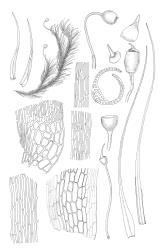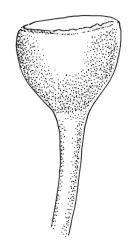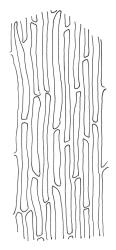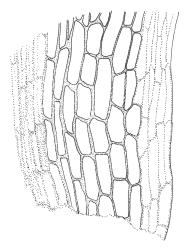Plants olive-green to black, usually yellow-green to dark green at tips, very soft and silky, lustrous. Stems rather soft, commonly to c. 90 mm, sparsely branched by forking and probably also by innovation, in cross-section with a central strand, firm-walled internal cells and a single layer of darkly-pigmented cortical cells. Leaves erect, flexuose to weakly secund when dry, unchanged when moist, often more secund at stem apex, with a narrowly oblong base and gradually narrowed to a filiform subula which is 3–5 times the length of the base, entire, subtubulose below, neither decurrent nor clasping at base, 9.0–12.0 × 0.5–0.6 mm; upper laminal cells (from upper portion of oblong base) linear and ± straight, strongly incrassate (the walls ± equal to the lumina), c. 60–100 × 3 µm, but with the lumina expanded slightly at cell ends; lower laminal cells similar; alar cells weakly differentiated, slightly inflated and thinner-walled than adjacent laminal cells, not auriculate, separated from the costa by several rows of elongate cells. Costa c. 60–90 µm wide below, mostly well-defined and filling the subula, in some leaves becoming ± ill-defined in lower portion of base, in cross-section with a layer of median guide cells.
Autoicous. Perichaetia terminating the stem but usually overtopped by innovation and occurring at several points on the well-developed plants; perichaetial leaves from a broadly oblong and sheathing base, abruptly shouldered and narrowed to a long and slender subula. Perigonia on short branches below the perichaetia. Setae 4.0–7.0 mm, straight or gently curved, not twisted; capsules turbinate and wide-mouthed when dry, ± hemispheric when moist, immersed in the perichaetial and surrounding vegetative leaves or emergent, yellow-brown at maturity and becoming dark brown with age, pachydermous, 0.6–0.9 × 0.7 mm diam.; exothecial cells highly irregular in shape and size, moderately incrassate and weakly collenchymatous, c. 5–6 rows thicker-walled, and oblate to isodiametric at rim; stomata not seen; operculum long and finely rostrate from a nearly plane base, longer than the capsule. Peristome reduced to a few, hyaline, rectangular cells. Calyptra as per genus. Spores 27–36 µm, smooth, green.
Bartlett & Vitt 1986, figs. 101–108.
I agree with Bartlett & Vitt (1986) that the long (c. 60–100 µm) and narrow cells of the upper portion of the leaf base and long, slender subulae facilitate recognition of this species. The taper from the leaf base to the subula is gradual (and accentuated by the subtubulose nature of the leaves). However, the leaves are not as evenly tapered as in B. robusta or B. magellanica. The alar cells of B. lewinskyae are only weakly differentiated.
Confusion is most likely with B. immersa. The relatively narrow (c. 60–90 µm wide below) and mostly well-defined costae with a median layer of guide cells in this species provide the most reliable means of separating it from B. immersa (where the costae are mostly 200–275 µm wide, ill-defined, and lack guide cells) when sterile. The length of the laminal cells in the upper portion of the leaf base also distinguishes these species. When fruiting, the differences in the length of their setae distinguishes them.
SI: Nelson (Stockton Plateau, Denniston Plateau, Big River, near Ikamatua), Westland (Taramakau River, near Kūmara, Doolan Creek, Pattison Creek, Ōkārito and vicinity). Blindia lewinskyae occurs abundantly at several of its known localities, including the Waimangaroa River and its tributaries on the Denniston Plateau, in streams on the Stockton Plateau, and at Doolan Creek (near Craigieburn, Westland L.D.).
Endemic.
Occurring submerged (or emergent at low flows) and on sandstone and granitic rock and derived gravels. Mostly in shallow streams of moderate flow. In the Waimangaroa River (Denniston Plateau, near confluence with Cedar Creek), B. lewinskyae is one of few bryophyte species dominating the epilithic, submerged vegetation. It co-occurs at this site with the aquatic hepatics Chiloscyphus austrigenus, Hepatostolonophora rotata var. rotata, and Pachyglossa tenacifolia (D. Glenny, pers. comm., 1 May 2015). The Waimangaroa River drains an extensive area of cushion bogs; the water is highly tannin-stained and very little insect life is present in this shallow river of moderate water speed, probably partly due to an acidic pH. Unusual habitats are recorded from Kōhuamārua Bluff (near Ōkārito), where this species occurred "in cascading water on littoral boulder within spray zone at high tide." Also, at Cemetery Creek (near Ōkārito) this species was collected from the "concrete bottom of [a] culvert." Bartlett & Vitt (1986) recorded B. lewinskyae as forming "pure stands on submerged rocks" at the Ōmoeroa River (Westland L.D.), a stream they described as having a similar peat bog source as the streams on the Denniston Plateau. The Ōmoeroa River material has not been available for study. A Bartlett collection of Blindia lewinskyae labelled (in herb.) from "Moa Park" (Pikikiruna Range, Nelson L.D., AK 197698 & CHR 590999) is of doubtful provenance; this locality is not recorded by Bartlett & Vitt (1986).
Older portions of plants of B. lewinskyae are often heavily encrusted with cyanobacteria. Herbarium records suggest that at some localities B. lewinskyae may co-occur with B. immersa. Occurring from sea level (near Ōkārito) to 900 m elevation (Mt Frederick, Stockton Plateau), with the bulk of herbarium records from c. 535–660 m.
At least some sterile paratype material (e.g., S. Berggren 226, CHR 570807) of B. immersa from the Taramakau River is better referred to B. lewinskyae.









